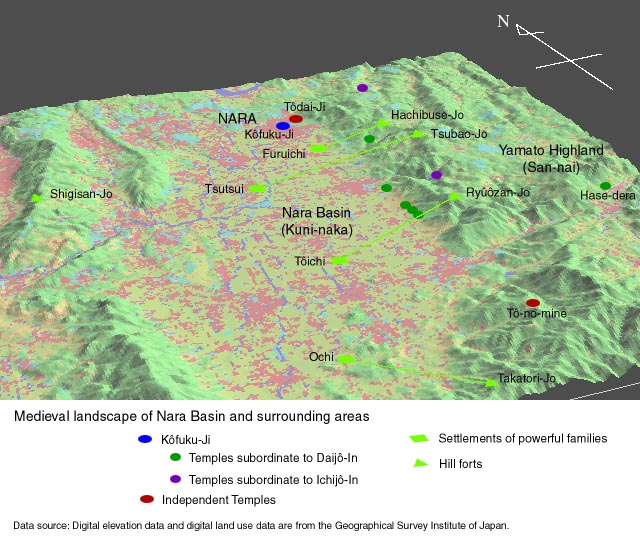
The medieval era of Japan is generally characterized as the age of warriors (samurai) and feudal lords (daimyô), but in Yamato Province (modern Nara Prefecture), Kôfuku-ji, a Buddhist monastery established by the Fujiwara family, occupied the seat of feudal power from which the province was ruled. Kôfuku-ji also subordinated almost all of the other Buddhist temples in the province. Only a few Buddhist temples were independent, including Tôdai-Ji in Nara, Tô-no-mine in Sakurai, and Kimpusen-Ji in Yoshino. Two monzeki (temples headed by priests from noble lineage), Daijô-in and Ichijô-in, occupied a central place in the power politics of Kôfuku-ji. There are several large Buddhist temples along the slope dividing the Nara Basin and the Yamato Highland. These temples, shown in the illustration below by green and purple dots, were subordinate to Kôfuku-ji. The authorities of Kôfuku-ji called them "San-ji (mountain temples)" and imposed tax and duties on them in the same way as on the other estates.

Since these temples were distributed along the edges of the Nara Basin, it is clear that the basin and the mountain areas were linked with each other and formed a cohesive region.
Family Hill fort Ochi Takatori-jô Tôichi Ryûôzan-jô Tsutsui Tsubao-jô Furuichi Hachibuse-jô
The Matsunaga family, who invaded Yamato Province in the 16th century, also built a hill fort in Shigisan. Settlements in the basin and hill forts in the mountain areas were typical features in the medieval landscape of the Nara region.
The distribution of Buddhist temples and hill forts reflects both contrastive and complementary relationships between the basin and mountain areas. Densely agglomerated settlements surrounded by moats (kango shuraku) are well known as a peculiar feature of the Nara Basin. However, I believe we can gain a better understanding of this region by focusing on the distribution of Buddhist temples and hill forts.
By Shuzo Murata, Osaka University